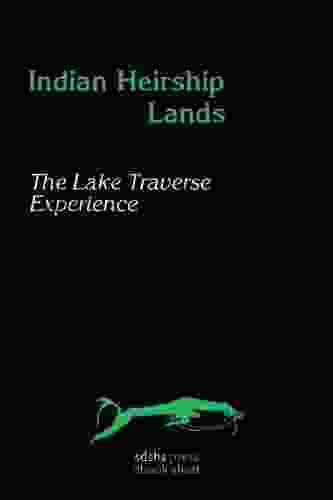Indian Heirship Lands: The Lake Traverse Experience

Indian heirship lands are a unique type of land ownership that exists in the United States. These lands were originally granted to Native American tribes by the federal government, but over time, they have been divided into smaller and smaller parcels through inheritance. As a result, many Indian heirship lands are now owned by multiple individuals, often with conflicting interests. This can make it difficult to manage and use the land, and it can also lead to disputes and litigation.
5 out of 5
| Language | : | English |
| File size | : | 106 KB |
| Text-to-Speech | : | Enabled |
| Screen Reader | : | Supported |
| Enhanced typesetting | : | Enabled |
| Word Wise | : | Enabled |
| Print length | : | 17 pages |
| Lending | : | Enabled |
The Lake Traverse Reservation in South Dakota is home to a large amount of Indian heirship land, and the community has been working to address the challenges associated with this type of ownership. This article will explore the history of Indian heirship lands, the challenges they present, and the efforts that are being made to address these challenges on the Lake Traverse Reservation.
History of Indian Heirship Lands
The history of Indian heirship lands begins with the Indian General Allotment Act of 1887. This act was passed by the federal government in an effort to assimilate Native Americans into American society. Under the act, Native American tribes were forced to divide their communal lands into individual allotments. Each member of the tribe was given a parcel of land, which they could then own and sell.
The Indian General Allotment Act had a devastating impact on Native American tribes. It led to the loss of millions of acres of land, and it disrupted traditional ways of life. Many Native Americans were forced to sell their allotments to non-Native buyers, and they ended up losing their land and their culture.
In the years since the Indian General Allotment Act was passed, the federal government has taken steps to address the problems that it created. In 1934, the Indian Reorganization Act was passed, which put a stop to the allotment of Indian lands. The act also created a process for tribes to buy back land that had been lost through allotment.
Despite these efforts, Indian heirship lands continue to be a problem today. There are an estimated 2 million acres of Indian heirship land in the United States, and much of this land is in a state of disrepair. The owners of Indian heirship lands often lack the resources to manage their land, and they may not be able to use it for traditional purposes. This can lead to a number of problems, including environmental degradation, poverty, and social unrest.
Challenges of Indian Heirship Lands
The challenges of Indian heirship lands are complex and varied. One of the biggest challenges is the issue of ownership. Many Indian heirship lands are owned by multiple individuals, often with conflicting interests. This can make it difficult to manage and use the land, and it can also lead to disputes and litigation.
Another challenge is the lack of resources. The owners of Indian heirship lands often lack the resources to manage their land. They may not have the money to pay for property taxes, insurance, or repairs. They may also not have the knowledge or experience to manage the land in a sustainable way.
The lack of resources can lead to a number of problems, including environmental degradation, poverty, and social unrest. Environmental degradation can occur when the land is not managed properly, which can lead to erosion, water pollution, and loss of wildlife habitat. Poverty can occur when the land is not used to generate income, which can lead to unemployment, homelessness, and hunger. Social unrest can occur when disputes over land ownership lead to violence and conflict.
Efforts to Address the Challenges of Indian Heirship Lands
There are a number of efforts underway to address the challenges of Indian heirship lands. One effort is to consolidate ownership of the land. This can be done through a process called partition, which divides the land into smaller parcels that are owned by individual individuals. Another option is to create a trust, which can hold the land in common for the benefit of all of the owners.
Another effort is to provide resources to the owners of Indian heirship lands. This can be done through a variety of programs, including land management training, financial assistance, and legal assistance. These programs can help the owners of Indian heirship lands to manage their land in a sustainable way and to generate income from the land.
Finally, there is an effort to raise awareness of the challenges of Indian heirship lands. This is being done through a variety of outreach programs, including public education campaigns and conferences. These programs are helping to raise awareness of the issue and to build support for solutions.
The efforts to address the challenges of Indian heirship lands are complex and challenging. However, there is a growing recognition of the need to address this issue. With continued effort, it is possible to find solutions that will benefit the owners of Indian heirship lands and their communities.
Indian heirship lands are a unique and challenging land ownership issue. The challenges of Indian heirship lands are complex and varied, but there are a number of efforts underway to address these challenges. With continued effort, it is possible to find solutions that will benefit the owners of Indian heirship lands and their communities.
5 out of 5
| Language | : | English |
| File size | : | 106 KB |
| Text-to-Speech | : | Enabled |
| Screen Reader | : | Supported |
| Enhanced typesetting | : | Enabled |
| Word Wise | : | Enabled |
| Print length | : | 17 pages |
| Lending | : | Enabled |
Do you want to contribute by writing guest posts on this blog?
Please contact us and send us a resume of previous articles that you have written.
 Top Book
Top Book Novel
Novel Fiction
Fiction Nonfiction
Nonfiction Literature
Literature Paperback
Paperback Hardcover
Hardcover E-book
E-book Audiobook
Audiobook Bestseller
Bestseller Classic
Classic Mystery
Mystery Thriller
Thriller Romance
Romance Fantasy
Fantasy Science Fiction
Science Fiction Biography
Biography Memoir
Memoir Autobiography
Autobiography Poetry
Poetry Drama
Drama Historical Fiction
Historical Fiction Self-help
Self-help Young Adult
Young Adult Childrens Books
Childrens Books Graphic Novel
Graphic Novel Anthology
Anthology Series
Series Encyclopedia
Encyclopedia Reference
Reference Guidebook
Guidebook Textbook
Textbook Workbook
Workbook Journal
Journal Diary
Diary Manuscript
Manuscript Folio
Folio Pulp Fiction
Pulp Fiction Short Stories
Short Stories Fairy Tales
Fairy Tales Fables
Fables Mythology
Mythology Philosophy
Philosophy Religion
Religion Spirituality
Spirituality Essays
Essays Critique
Critique Commentary
Commentary Glossary
Glossary Bibliography
Bibliography Index
Index Table of Contents
Table of Contents Preface
Preface Introduction
Introduction Foreword
Foreword Afterword
Afterword Appendices
Appendices Annotations
Annotations Footnotes
Footnotes Epilogue
Epilogue Prologue
Prologue M V Kasi
M V Kasi Larry Hama
Larry Hama Talya Rubin
Talya Rubin Lionel Martellini
Lionel Martellini Sheri Koones
Sheri Koones Henry William Herbert
Henry William Herbert Nancy Holder
Nancy Holder Marialisa Demora
Marialisa Demora Kiki Prottsman
Kiki Prottsman Norm Foster
Norm Foster India Edghill
India Edghill Andrew J Clark
Andrew J Clark Kristen Thrasher
Kristen Thrasher William Simpson
William Simpson Salvatore Stefanelli
Salvatore Stefanelli William Havelock
William Havelock Kenneth Pomeranz
Kenneth Pomeranz Liliana Hart
Liliana Hart Jerome Charyn
Jerome Charyn Gareth L Powell
Gareth L Powell
Light bulbAdvertise smarter! Our strategic ad space ensures maximum exposure. Reserve your spot today!
 Aubrey BlairFollow ·17.5k
Aubrey BlairFollow ·17.5k Hayden MitchellFollow ·17.3k
Hayden MitchellFollow ·17.3k Bobby HowardFollow ·12.3k
Bobby HowardFollow ·12.3k Cristian CoxFollow ·16.7k
Cristian CoxFollow ·16.7k Hugh ReedFollow ·16.4k
Hugh ReedFollow ·16.4k Carl WalkerFollow ·6.5k
Carl WalkerFollow ·6.5k Allen ParkerFollow ·6.3k
Allen ParkerFollow ·6.3k Josh CarterFollow ·2.7k
Josh CarterFollow ·2.7k

 Jeremy Mitchell
Jeremy MitchellPlay We Now On Christmas Violin Christmas: A Heartfelt...
Play We Now On...

 Terry Bell
Terry BellTales from the Road: Confessions of an Atlanta Uber...
In the vibrant...

 Ervin Bell
Ervin BellThe French Admiral: A Gripping Naval Adventure with Alan...
In the vast expanse of...

 Henry David Thoreau
Henry David ThoreauCrochet Cozy Afghan Patterns: Crochet Weekend Afghan...
to Crochet...

 Orson Scott Card
Orson Scott CardAn Archaeological View Of The Industrialization Of North...
The industrialization of North America was a...

 Josh Carter
Josh CarterClipboard Christmas Skits by Tom Spence: A Festive...
A Christmas...
5 out of 5
| Language | : | English |
| File size | : | 106 KB |
| Text-to-Speech | : | Enabled |
| Screen Reader | : | Supported |
| Enhanced typesetting | : | Enabled |
| Word Wise | : | Enabled |
| Print length | : | 17 pages |
| Lending | : | Enabled |












